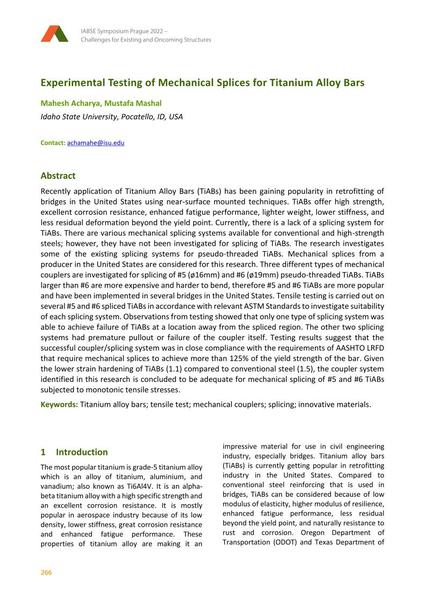Experimental Testing of Mechanical Splices for Titanium Alloy Bars

|
|
|||||||||||
Bibliografische Angaben
| Autor(en): |
Mahesh Acharya
(Idaho State University, Pocatello, ID, USA)
Mustafa Mashal (Idaho State University, Pocatello, ID, USA) |
||||
|---|---|---|---|---|---|
| Medium: | Tagungsbeitrag | ||||
| Sprache(n): | Englisch | ||||
| Tagung: | IABSE Symposium: Challenges for Existing and Oncoming Structures, Prague, Czech Republic, 25-27 May 2022 | ||||
| Veröffentlicht in: | IABSE Symposium Prague 2022 | ||||
|
|||||
| Seite(n): | 266-271 | ||||
| Anzahl der Seiten (im PDF): | 6 | ||||
| DOI: | 10.2749/prague.2022.0266 | ||||
| Abstrakt: |
Recently application of Titanium Alloy Bars (TiABs) has been gaining popularity in retrofitting of bridges in the United States using near-surface mounted techniques. TiABs offer high strength, excellent corrosion resistance, enhanced fatigue performance, lighter weight, lower stiffness, and less residual deformation beyond the yield point. Currently, there is a lack of a splicing system for TiABs. There are various mechanical splicing systems available for conventional and high-strength steels; however, they have not been investigated for splicing of TiABs. The research investigates some of the existing splicing systems for pseudo-threaded TiABs. Mechanical splices from a producer in the United States are considered for this research. Three different types of mechanical couplers are investigated for splicing of #5 (ø16mm) and #6 (ø19mm) pseudo-threaded TiABs. TiABs larger than #6 are more expensive and harder to bend, therefore #5 and #6 TiABs are more popular and have been implemented in several bridges in the United States. Tensile testing is carried out on several #5 and #6 spliced TiABs in accordance with relevant ASTM Standards to investigate suitability of each splicing system. Observations from testing showed that only one type of splicing system was able to achieve failure of TiABs at a location away from the spliced region. The other two splicing systems had premature pullout or failure of the coupler itself. Testing results suggest that the successful coupler/splicing system was in close compliance with the requirements of AASHTO LRFD that require mechanical splices to achieve more than 125% of the yield strength of the bar. Given the lower strain hardening of TiABs (1.1) compared to conventional steel (1.5), the coupler system identified in this research is concluded to be adequate for mechanical splicing of #5 and #6 TiABs subjected to monotonic tensile stresses. |
||||
| Stichwörter: |
Zugversuch
|
||||
| Copyright: | © 2022 International Association for Bridge and Structural Engineering (IABSE) | ||||
| Lizenz: | Die Urheberrechte (Copyright) für dieses Werk sind rechtlich geschützt. Es darf nicht ohne die Zustimmung des Autors/der Autorin oder Rechteinhabers/-in weiter benutzt werden. |
||||
